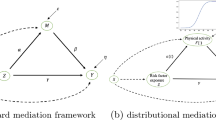Abstract
This paper illustrates the variety of PERT technique known as random PERT. The aim of this technique is to help plan the duration of activities, something which can be particularly difficult in psychosocial programs. Thus, this task is often carried out by experts, who know that there are many events which may modify the proposed calendar. The paper includes an empirical illustration of random PERT applied to a physical activity/sports program for elderly people.
Similar content being viewed by others
References
Alberich C. (1995). El PERT: Un instrumento de gestión de proyectos. Institut Valencià d’Estudis en Salut Pública, Valencia
Azaron A., Perkgoz C. and Sakawa M. (2005). A genetic algorithm approach for the time-cost trade-off in PERT networks. App. Math. Comput. 168: 1317–1339
Chae K.C. (1990). A geometric interpretation of the PERT assumptions on the activity time. Int. J. Math. Edu. Sci. Technol. 21: 283–288
Chae K.C. and Kim S. (1990). Estimating the mean and variance of PERT activity time using likelihood-ratio of the mode and the midpoint. IEE Trans. 22: 198–203
Chau D.K.H., Chan W.T. and Govindam K. (1997). A time-cost trade-off model with resource consideration using genetic algorithm. Civil Eng. Syst. 14: 291–311
Collantes A. (1982). El PERT. Index, Barcelona
Farnum N.R. and Stanton L.W. (1987). Some results concerning the estimation of beta distribution parameters in PERT. J. Operat. Res. Soc. 38: 287–290
Feng C.W., Liu L. and Burns S.A. (1997). Using genetic algorithms to solve construction time-cost trade-off problems. J. Construct. Eng. Manage. ASCE 11: 184–189
Gallagher C. (1987). A note on PERT assumptions. Manage. Sci. 33: 1360
Golenko-Ginzburg D. (1988). On the distribution of activity time in PERT. J. Operat. Res. Soc. 39: 767–771
Golenko-Ginzburg D. (1989). PERT assumptions revisited. Omega, Int. J. Manage. Sci. 17: 393–396
Hernández Mendo A. and Anguera M.T. (2001). Análisis psicosocial de los programas de actividad física: Evaluación de la temporalidad. Psicothema 13(2): 263–270
Kamburowski J. (1997). New validations of PERT times. Omega, Int. J. Manage. Sci. 25(3): 323–328
Keefer D.L. and Verdini W.A. (1993). Better estimation of PERT activity time parameters. Manage. Sci. 39: 1086–1091
Kersner H. (1998). Project Management: A System Approach to Planning, Scheduling and Controlling. Wiley, New York
Kulkarni V. and Adlakha V. (1986). Markov and Markov-regenerative PERT networks. Operat. Res. 34: 769–781
Littlefield T.K. and Randolph P.H. (1987). An answer to Sasieni’s question on PERT times. Manage. Sci. 33: 1357–1359
Littlefield T.K. and Randolph P.H. (1991). PERT duration times: mathematics or MBO. Interfaces 21: 92–95
Muscatello D.B. (1988). Developing an agenda that works: the right choice at the right time. In: McLaughlin, J.A., Weber, L.J., Covert, R.W. and Ingle, R.B. (eds) Evaluation utilization, pp 21–31. Jossey-Bass, San Francisco
Pillai A.S. and Tiwari A.K. (1995). Enhanced PERT for programme analysis, control and evaluation: PACE. Int. J. Project Manage. 13(1): 39–43
Prado D. (1988). Administración de proyectos PERT/CPM. Paraninfo, Madrid
Rhiel, G.S.: A refinement of the PERT assumptions. In: Proceedings of the decision sciences institute national meeting, San Diego, 773–775 (1990)
Sánchez-Algarra P. and Anguera-Argilaga M.T. (1993). Aproximación al PERT en evaluación de programas desde las técnicas matemáticas de análisis de grafos. Anales de Psicología 9(2): 213–226
Sánchez-Algarra, P., Anguera-Argilaga, M.T.: Time management in the cost evaluation of limited resource programs. Qual & Quant. 39 (4), 391–411 (2005)
Sasieni M.W. (1986). A note on PERT times. Manage. Sci. 32: 1652–1653
Sculli D. (1989). A historical note on PERT times. Omega, Int. J. Manage. Sci. 17: 195–200
Somarajan, R.C., Girardeau, C., Li, J.: A proposal on improved procedures for estimating task-time distributions in PERT. In: Proceedings of the decision sciences institute national meeting, San Francisco, 1109–1111 (1992)
Williams T.M. (1995). What are PERT estimates?. J. Operat. Res. Soc. 46: 1498–1504
Yu Chuen-Tao, L.: Aplicaciones Prácticas del PERT y CPM: Nuevos Métodos de Dirección para Planificación, Programación y Control de Proyectos. Editorial Deusto, Bilbao (1989)
Author information
Authors and Affiliations
Corresponding author
Rights and permissions
About this article
Cite this article
Morales-Sánchez, V., Hernández-Mendo, A., Sánchez-Algarra, P. et al. Random PERT: application to physical activity/sports programs. Qual Quant 43, 225–236 (2009). https://doi.org/10.1007/s11135-007-9124-0
Received:
Accepted:
Published:
Issue Date:
DOI: https://doi.org/10.1007/s11135-007-9124-0



